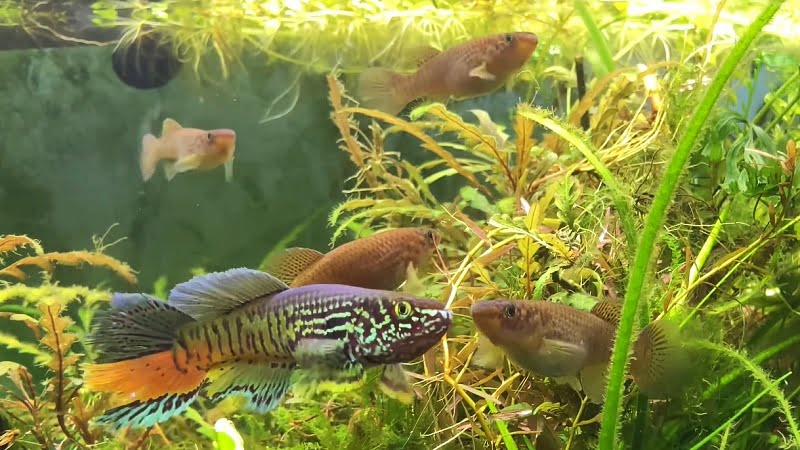Killifish is a fantastic fish that you should add to your fish tank. They have vibrant colors, interesting patterns, and relatively peaceful behavior. Depending on the species, the temperament can be easy-going to aggressive, and the tank setup requirements can be significantly different.
To build a harmonious and healthy killifish community tank, there are several points you should keep in mind: the water-condition compatibility, size and temperament of each fish species, and feeding activity.
This article will provide sufficient information about the killifish in aquariums and essential remarks on keeping them with other fish varieties.
3 Notes For A Good Killifish Community Tank
Housing recommendations
- 5 – 10 gallon tank can be used to keep a trio of Killifish in the same species.
- 20-gallon or bigger tank is suitable to keep a killifish community with more than one male.
- An aquarium that mimics their natural habitat is ideal for the killifish. Particularly, the lighting should be dim, the tank should be filled with driftwood or peat moss for softening the water and getting lower pH level, accompanying the low-light tolerant plants, including Cryptocorynes, Java moss, and Java.
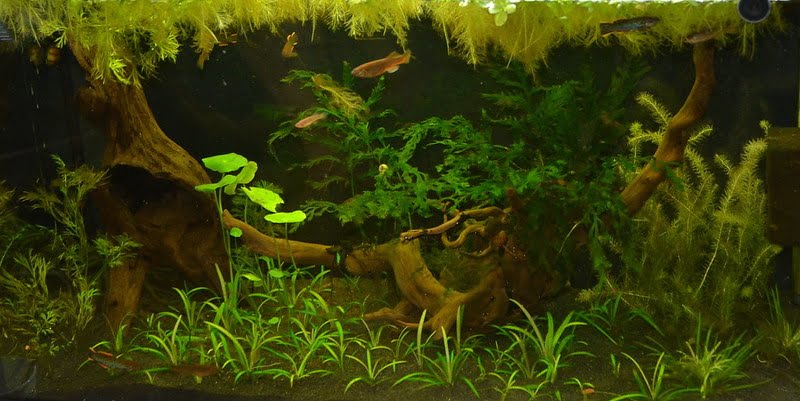
Keeping killifishes together
As male Killifishes are getting aggressive towards each other, it is recommended to keep one male with two females in the small tank (~5 gallons).
With a bigger tank (more than 30 gallons), it is possible to keep many male killies together since they will have more space and places to hide from the other bullied males. For this tank size, you can have a community of around 12 individuals.
Keeping killifish with other fishes
Though Killifish is quite peaceful, they can become aggressive and territorial, depending on the species. For example, the Blue Gularis killifish – the largest species – has an aggressive temperament and should be kept in a separate tank or together with the more relaxed and bigger fish varieties.
Owing to their living conditions, the ideal tankmates must be the ones able to live in low-light, soft acidic water conditions.
Recommended:
- Other peaceful and same-size species.
- Bottom-dwelling fishes, like Corydoras and Kuhli Loaches, can be great tank mates for them since the Killifish remain in the top half of the water column.
- Some other good tank mates can be Tetras, Rasboras, and livebearers of a similar size.
- The bigger Dwarf Gouramis, because their size is not much larger, compared to the Killies’ size.
Avoid:
- The species that has similar look to that of the Killifish male version.
- Larger and more aggressive fishes like Angelfish and Barbs, as they will stress your Killifish out.
- Fish species that are smaller than the Killies (like fry), because they will be eaten by the Killies.
- Invertebrates such as Shrimp and Snails because they will be tasty snacks for your killifish. Also, they are not suitable for living in the soft water condition as their calcium carbonate shells will be eaten away.
The Best Killifish Species For A Community Tank
Here are some of the best killifish species that can be a perfect addition to your freshwater community tank.
Golden panchax (Aphyosemion australe)
Usually, this species can be found in swamps or slow-moving rivers with a calm water current. Their maximum size can be about 2.5 inches (6.5 cm). They are relatively shy when being in an aquatic community.
The Golden panchax does best in the tank setup full of plants and various places to hide and get the dim lighting.
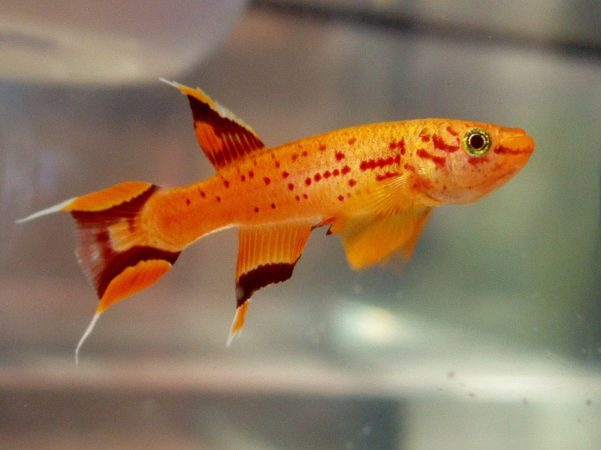
Clown killifish/banded panchax (Epiplatys annulatus)
Clown killifish usually inhabits slow-moving streams and rivers with dense vegetation across savannahs and rainforests.
They are small fish with a max size of around 1.5 inches (3.8 cm). Their appearance has an alternating black-and-yellow pattern with a signature red and blue caudal fin.
The clown killifish should be kept with the species having the same size and not too outgoing or vigorous.
The water conditions they can live well are 5.0 – 7.7 pH and astable water temperature of 22.2 – 25.0°C.
The setting for this killifish community tank requires a considerable amount of live plants, sand substrate, driftwoods, and dim lighting. Tannic acids, like ones from Indian almond leaves, are recommended to add to the tank since they can help keep a more acidic pH level and create dimmed conditions.
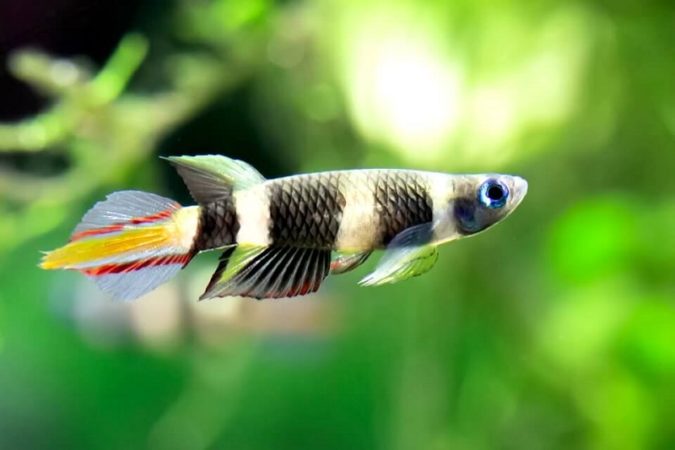
Golden wonder killifish/striped panchax (Aplocheilus lineatus)
This killifish species can live in both freshwater and brackish water conditions. They often feed on insects from the surface waters of streams, rivers, and swamps.
They have a small size which is about 2.5 – 4 inches (6.4 – 10 cm).
The Golden wonder killifish prefer tropical water conditions, including the 22.2 – 25.0°C stable water temperature of 22.2 – 25.0°C and a neutral pH level of about 7.0.
They are sometimes semi-aggressive and should not be mixed with smaller fishes such as neon teras and guppies.
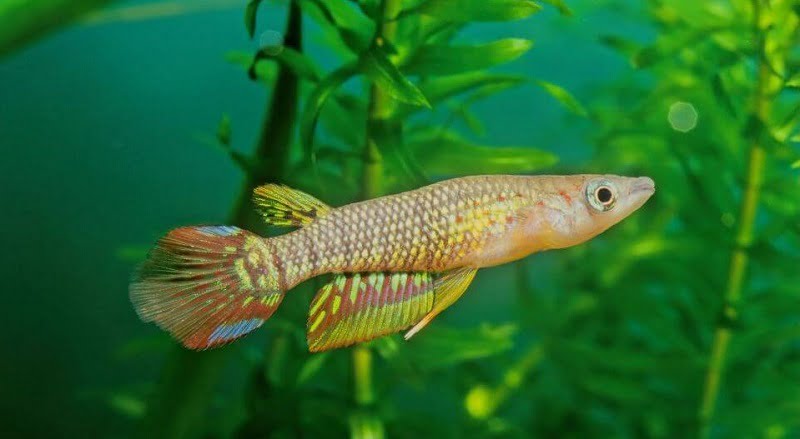
Redtail notho (Nothobranchius guentheri)
The redtail notho, or the Guentheri killifish, is another beautiful killifish species for your aquarium, but keeping them required more extra care than the mentioned killifish species.
The redtail notho is an annual fish, in other words, they only survive for the rainy season. The female lays eggs that can withstand drought conditions just before the dry season begins, and as soon as the rain season start, new populations will be born.
In the aquarium, the expected lifespan of this species is around 1 – 2 years.
They have bright red caudal fins and a size of about 2 inches (5 cm).
A tank with a backdrop of dense vegetation will be ideal for making them stand out. The ideal water temperature is about 22.2 – 25.0°C, along with 7.0 pH.
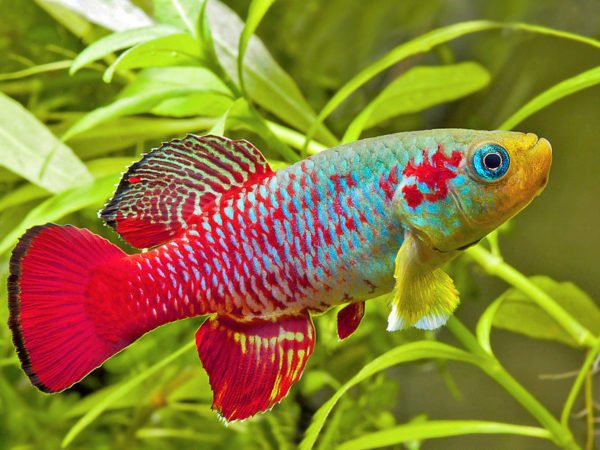
Bluefin notho (Nothobranchius rachovii)
Similar to the redtail notho, the bluefin notho is an annual fish, which may be challenging to preserve in the aquarium. They are named after their spectacular blue fins and body.
The bluefin notho has spectacular blue fins and body and grows to about 2 inches (5.1 cm).
They prefer a slightly cooler water temperature range of 20.0 – 23.9°C with a neutral pH level of 7.0.
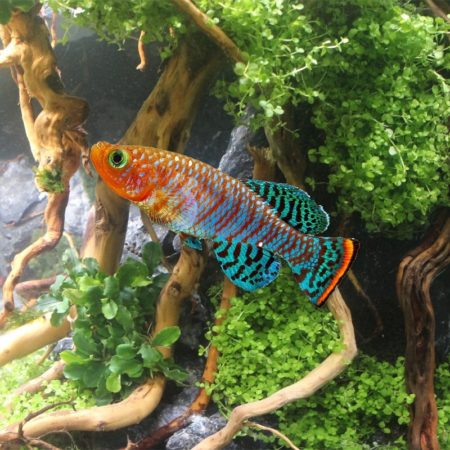
Video: Nano Killifish Community Tank
FAQs
Can other fishes live in a killifish community tank?
Yes. The killifish species are compatible with other calm and small fish species, particularly having the same size, and sharing similar water conditions. It is essential to note that good tank mates can be selected only when you consider the specific killifish species you have.
What size tank does a killifish need?
Each killifish may require a 2-gallon tank.
Are killifish bottom dwellers?
No. The killifish live in the top half of the water column and eat at the surface level of the fish tank.
Conclusion
The article includes useful information about the water-condition compatibility, size and temperament, and feeding activity of the killifish to help build a harmonious and healthy killifish community tank.
The suggestions about tank mates for killifish and killifish species that are good for a community aquarium are also demonstrated. I hope that the findings in this article can help you get the right killifish and other fish varieties for your home aquarium.

Annette M. Chaney is an experienced marine biologist with over 20 years of experience as an aquarist and fishkeeper. She started her first aquarium at a young age, filling it with frogs and goldfish obtained from the ten-cent pet store.
Annette grew up caring for and breeding African Cichlids, which led to a hobby in high school that doubled as a profitable means. Attending Reed College gave her time to solidify herself as an accomplished aquarium caretaker with an eye for sales. After that, from 2009 – 2013, she studied at Roger Williams University – one of the most prestigious universities for Aquaculture and Aquarium in USA. She is the founder of AquariumCircle since 2010.
